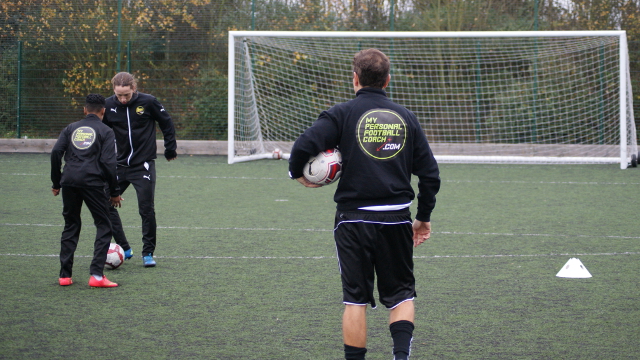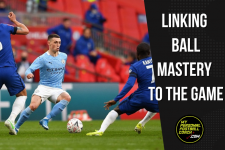A Quick Recap
Part 1: Routes to the end goal – A closer look at what we are trying to achieve and the part 1v1 soccer skills coaching can take especially in younger footballers.
Part 2: Learning Mechanisms & Education – As well teaching and coaching football, I am a keen student of the game so I highlight some of the education and sports science which contributes to my philosophy in developing footballers.
Foundation phase examples
In part 2 I talked extensively about Scaffolding Theory as a mechanism of learning and during my career so far I have found this methodology of coaching to be very successful. Seven boys I have worked with in 2 age groups for 2 years across the foundation phase are now in the England Youth Set up. I have also had numerous success stories working as an individual coach, supporting players into the Academies of Arsenal, Chelsea, Tottenham and more.

I Worked with him 1on1 2-3 times a week concentrating on 1v1 domination and all round technical development. Within a space of a year we managed to make him proficient with both feet, so much so that he was and is comfortable taking corners with both feet. We concentrated on 8 1v1 techniques that he mastered on both sides, from which he then experiments and progressed all of these techniques as he wished. Learning these ‘core skills’ gave him the ability to further advance and develop his own skills. He was now balanced on both sides and could go each way.
I read an interesting blog recently where a coach discussed the problems with isolated skill training, saying it curtailed creativity. I think as discussed previously, isolated 1v1 soccer skills training should and will actually improve creativity. The blog then continued to promote the use of ‘rondos’ and that youth development programmes should revolve around these. I feel this potentially may curb creativity, especially in the foundation phase as too much time spent on these ‘possession’ drills, which encourage 1 and 2 touch play, doesn’t promote dribbling and spending time on the ball. It also won’t encourage players into trying things and making mistakes with dribbling skills…This raises alarm bells as there is a real danger of producing ‘1 or 2 touch robots’ players who are great at passing and receiving but are unable to deal with a 1v1 situation by themselves.
I firmlt believe that Rondos should be used in the foundation phase, but alongside 1v1 skills training and SSGs. We need to give the dribblers the time and space to explore. The blogger asks ‘Have you ever seen children in a park run skill drills?’ The answer is more often than not a ‘no’ but I have often seen players practising and experimenting 1v1 soccer skills by themselves in the park. Growing up in the same area and going to the same school as England international soccer player Joe Cole, I saw first hand where a young players obsession with the ball could get him. Joe always had a ball at his feet and spent hours practising unopposed.
This is why I’m so passionate about training this way, because i have seen the effect it can have on players, I have seen first hand how it can actually make them more creative. These examples could be seen as anecdotal and that is why it’s important to look at other environments that have a similar training methodology.
There are 2 academies in England that I have experience of who also employ a Scaffolded learning environment, these are currently the producers of the most English Youth Team players in the country and beside what some would have you believe, the current English youth teams players are some of the best in Europe
The Ajax way
An insight into the Ajax coaching methods
This goes to show how far English football has come and these players have come through the Academy system, many from 8 years old. I know as i worked with several of them. The English Academy system gets knocked far too easily when in reality there is some excellent work going on that we are now seeing the fruits of.
Which way is best?
There is no silver bullet or secret recipe in developing top level footballers because there are many different environments that are getting results. However, what is clear to me is that there is a role for the coach in developing and creating challenging environments for the player. I am convinced that in this country in particular (England), we need to develop a culture of 1v1 and skilful players as these environments are alien to most of our players at the moment. Working in this way can and will improve a players technique and their ability to dominate 1v1 more often in a game situation. This is NOT just ‘about creating dribblers’ because it is vital that players in all positions on the pitch need to be comfortable on the ball under pressure and be able to solve the 1v1 challenge.
This in turn I argue will actually give them the tools to be more creative as I have seen this first hand. Most team sessions should be opposed, but we must cultivate an environment that encourages and demands that a player has a deep relationship with the ball. In England at the moment, we don’t have this and with the death of street football, it is more important than ever as coaches that we manipulate and construct environments to best replicate this.
Saul Isaksson-Hurst
Head Coach at MyPersonalFootballCoach.com





